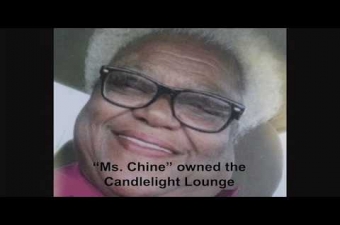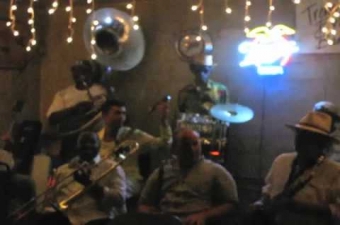Candlelight Lounge/Grease Lounge
925 N. RobertsonNew Orleans LA 70116
The Candlelight Lounge, a low-key neighborhood bar, took on outsized significance after Hurricane Katrina when it became the last redoubt of live music in Treme. The neighborhood had been a musical hotbed for more than century, but with longtime residents displaced after the flood, new neighbors and rising costs changed the character of the area. In 2014 the Cornerstones project and Tulane City Center collaborated with the Candlelight community to document the significance of the club:
Barrooms are intensively-used spaces, and they can be viewed as ‘nuisance’ uses in communities, but in New Orleans, barrooms like the Candlelight Lounge have been central to some of the city’s most prominent cultural activities, as well as serving socially fundamental functions, such as providing food to hungry regulars or serving as a gig networking space for local musicians. The Candlelight and similar spaces in the city should not be overlooked for the important functions they play in keeping communities connected, particularly in times of disruption, like Hurricane Katrina, or major change, like gentrification, when residents profoundly need the continuity and comfort of community and tradition.
The Candlelight addressed these needs thanks largely to Leona Grandison—known as Ms. Chine—who opened the lounge with her brother Landry Grandison in 1985. A Treme native, she made the club a second home for musicians, social aid and pleasure clubs, and other neighborhood residents. Music, along with her cooking, was a regular attraction on weekends. Sunday second lines often stopped at the Candlelight, and the White Cloud Hunters Mardi Gras Indians held practices here in the 80s.
When Grandison’s business plummeted after Hurricane Katrina, brass band luminary Benny Jones (a relative by marriage) stepped in to help keep the Candlelight afloat. Jones, another Treme native, brought his Treme Brass Band to the club on Wednesday nights, and built an audience using his relationships in the second line community and the music business—he co-founded the Dirty Dozen Brass Band in the 70s before forming the Treme Brass Band in the 90s. The gig gave old regulars a chance to stay connected to the neighborhood and visitors a taste of the scene that defined Treme before it became a destination.
Jones’ nephew, trombonist and bandleader Corey Henry, grew up in the neighborhood, too. In the 90s he went to the Candlelight to listen to brass bands like Tuba Fats’ Chosen Few, and started playing here on Sunday nights after the storm to connect a younger generation to the tradition. (The future of his own musical family looks bright: his daughter, Jazz Henry, plays in the Pinettes Brass Band.)
The barroom’s legacy as a brass band headquarters goes back even further than Grandison. Before she took over it was called the Grease Lounge, for manager Gregory “Grease” Davis, Sr. (His son, Gregory Davis, Jr., is the longtime trumpeter with the Dirty Dozen). The elder Davis hosted the Rebirth Brass Band here when several members were still students at nearby Clark High School. Then known as the Rebirth Jazz Band, they made their first recording in the bar, Here to Stay: Live at the Grease Lounge, 1984. WWOZ co-founder Jerry Brock set up the session for the teenagers, who would become a dominant influence in brass band music in the decades to come.
The Grease Lounge also featured blues and R&B artists (the Candlelight continued these bookings in its early years). One was Barbara George, who’d scored a national hit with “I Know” on Treme-based AFO Records in 1961. The 19-year-old singer brought the lyrics to the great Harold Battiste, who composed music for them based on the chords to the gospel song “Just a Closer Walk With Thee.” He also wrote a solo for cornetist Melvin Lastie to play on the record which became a touchstone of New Orleans R&B. The song looked like it would launch AFO Records to the big time, but a disgruntled business partner of Battiste lured George to another label, and both foundered. She left the music business in the 70s but started gigging again in the 80s at small clubs like the Grease Lounge.
Today, the Candlelight, along with Tuba Fats Square on the next lot and Charbonnet-Labat-Glapion funeral home around the corner, anchors a segment of Treme that has resisted gentrification. This has been possible because Grandison was one of the few operators of Black nightclubs in New Orleans who managed to buy the property she managed, and the owners of Tuba Fats Square and the funeral home are also committed to supporting neighborhood traditions. Sadly, Grandison’s family has to carry on the mission without her: she passed away after contracting the coronavirus in the early stages of the COVID-19 outbreak in New Orleans. Prohibitions against public gatherings during the pandemic prevented her from receiving a proper jazz funeral, but a memorial went up on the sidewalk in front of the Candlelight.
For more about the Treme neighborhood, click here.
Videos

From April 2020, a remembrance of Leona "Ms. Chine" Grandison amid the COVID-19 pandemic.
Video by Nola.com.
From April 2020, a remembrance of Leona "Ms. Chine" Grandison amid the COVID-19 pandemic.

The Treme Brass Band performs at the Candlelight in 2010, featuring "Uncle" Lionel Batiste on bass drum and vocals from Kenny Terry on "Lil Liza Jane."
Video posted by Tom Roche.
The Treme Brass Band performs at the Candlelight in 2010, featuring "Uncle" Lionel Batiste on bass drum and vocals from Kenny Terry on "Lil Liza Jane."

The Treme Brass Band performs at the Candlelight in 2012, with guest vocals from Bruce Sunpie Barnes. (Don't let the lack of a preview image throw you.)
Video posted by dylanjames67.
The Treme Brass Band performs at the Candlelight in 2012, with guest vocals from Bruce Sunpie Barnes. (Don't let the lack of a preview image throw you.)
Images

















